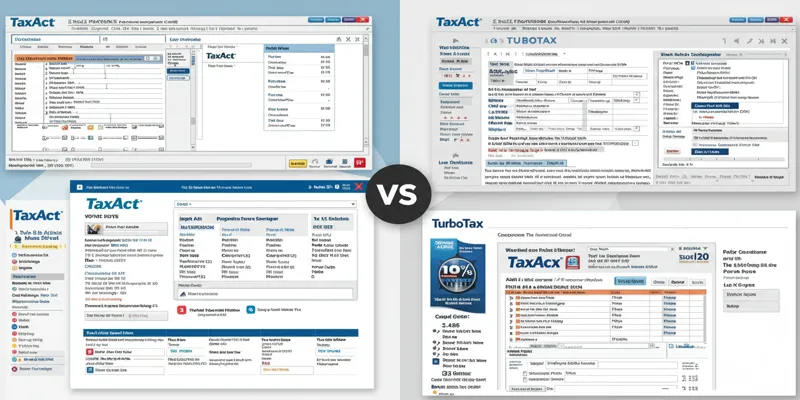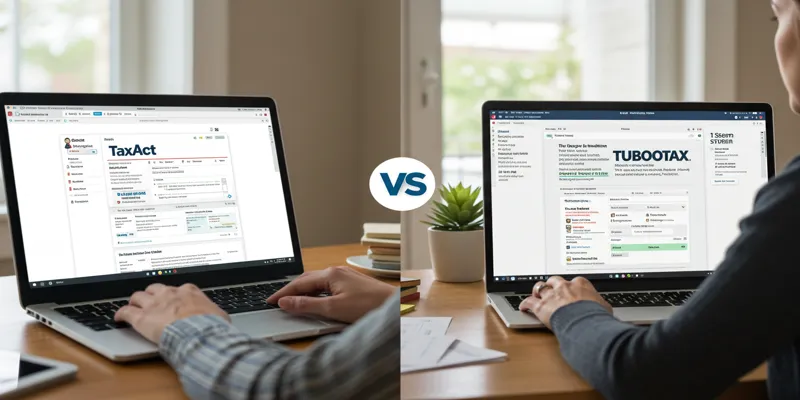TaxAct vs. TurboTax: Which Tax Filing Software is Right for You?
As the tax season draws near, choosing between TaxAct and TurboTax is a critical decision for successful tax filing. Both software solutions offer comprehensive tools to assist with your tax returns. But which one truly suits your needs? In this post, we’ll analyze the features, pricing, user experience, and support options for TaxAct versus TurboTax to help you make an informed decision.
Ease of Use: Comparing the Tax Software Interfaces
 If you’re
filing your taxes, ease of use is essential. While both TaxAct and TurboTax
aim to simplify the tax filing process, they differ in their approaches to
design and simplicity.
If you’re
filing your taxes, ease of use is essential. While both TaxAct and TurboTax
aim to simplify the tax filing process, they differ in their approaches to
design and simplicity.
Interface Design
TurboTax is renowned for its slick, modern interface. Users appreciate its clean, uncluttered design, making it easy to navigate through the filing process with the help of a progress bar. Conversational prompts simplify complex tax concepts for better understanding.
On the other hand, TaxAct’s interface is more traditional but very functional. Its straightforward design, featuring a left-hand menu, allows easy navigation between sections. While not as visually appealing as TurboTax, TaxAct’s no- frills approach can be refreshing for some users.
Guidance and Support
TurboTax excels in guided preparation by asking simple questions about your life and finances to determine the necessary IRS forms. This feature makes it an excellent choice for tax rookies.
TaxAct offers guidance but assumes a basic understanding of taxes. This can be beneficial for experienced filers looking for a quicker process, though it may require more effort for first-time filers or those with complex tax situations.
Mobile Experience
In today’s mobile-centric world, accessibility is crucial. TurboTax’s robust mobile app mirrors its desktop experience and allows users to import W-2 information by taking a photo.
TaxAct also offers a mobile app, though it lacks some of TurboTax’s features. While suitable for basic tasks and status reviews, it may be limiting for more complex filings.
Features and Tools: Which Offers More for Your Tax Needs?
 Analyzing TaxAct and
TurboTax involves examining the features and tools each software offers to
streamline your tax filing process. Both provide options for various tax
situations, but key differences exist.
Analyzing TaxAct and
TurboTax involves examining the features and tools each software offers to
streamline your tax filing process. Both provide options for various tax
situations, but key differences exist.
User Interface and Navigation
TurboTax’s intuitive interface guides users through tax preparation with a Q&A; feature. Its sleek, modern dashboard clearly shows your progress, making it user-friendly even for beginners.
Tax Deduction Finders
Both services help maximize deductions, but TurboTax’s “DeductionFinder” stands out with its extensive database of potential deductions based on profession, location, and life events. TaxAct’s deduction locator also works well but may require more manual input.
Import Capabilities
TurboTax leads in import capabilities, allowing direct imports from employers and financial institutions. It can also import previous years’ returns from other tax software. TaxAct offers import features but with a more limited selection of compatible forms.
Audit Support
While both services offer audit assistance, TurboTax provides a more comprehensive package with its “Audit Support Guarantee,” which includes guidance from a tax professional. TaxAct’s audit support is more basic, offering resources and explanations rather than personalized assistance.
Pricing and Value: Determining the Best Bang for Your Buck
Cost plays a significant role in choosing tax preparation software. While both TaxAct and TurboTax have tiered pricing, their value propositions differ.
Free Versions: Entry-Level Options
Both offer free versions for simple returns. TaxAct’s free option covers more forms, including Form 1040 with some schedules. TurboTax’s free version is slightly limited but provides a user-friendly interface for basic filers.
Paid Tiers: Features vs. Cost
TaxAct generally offers more affordable pricing for its Deluxe, Premier, and Self-Employed options compared to TurboTax. Although TurboTax is pricier, it compensates with enhanced functionality and user experience. TaxAct’s mid-tier options are suitable for moderately complex taxes, while high-end versions provide more guidance, making them worth the extra cost for some users.
Additional Services: Weighing the Extras
Both services offer extras related to audit support and expert review. TurboTax excels in service quality, though this increases costs. TaxAct provides budget-friendly additions, albeit with less depth.
Long-term Value: Beyond the Current Tax Year
Long-term value is essential when choosing between TaxAct and TurboTax. TurboTax saves time and reduces errors by allowing users to import previous returns from competitors. Switching to TaxAct may require more manual data entry.
Accuracy and Support: Ensuring a Smooth Tax Filing Experience
Accuracy is crucial during tax season. TaxAct and TurboTax both offer robust features to ensure accurate returns that comply with new tax laws.
Accuracy Guarantees
TurboTax offers a 100% Accuracy Guarantee, covering any penalties and interest from IRS audits due to software calculation errors. TaxAct provides a similar guarantee for calculation errors.
Error Checking and Review Process
Both services use advanced algorithms to catch potential mistakes before filing. TurboTax’s CompleteCheck reviews returns for errors and missed deductions, while TaxAct’s Double-Check system ensures return accuracy.
Customer Support Options
For support, both services offer multiple options:
- TurboTax: Live chat, phone support, and an extensive online knowledge base.
- TaxAct: Email and phone support, with priority support for higher-tier plans.
Audit Support
Each service provides some level of audit support:
- TurboTax: Essential audit support for all plans, with additional comprehensive audit representation available for a fee.
- TaxAct: Free audit support guidance, with professional representation offered at an extra cost.
Conclusion
Ultimately, both TaxAct and TurboTax are reliable tax preparation solutions catering to different filer needs. Your choice depends on your tax situation, budget, and preferences. TurboTax is ideal for those seeking an exceptional user experience and guidance, while TaxAct offers a cost-effective solution without sacrificing accuracy, making it suitable for confident filers or those with simple returns. Whatever service you choose, gather all necessary documents, maximize deductions, and file early to avoid last-minute stress. By weighing the pros and cons, you can make an informed decision and approach your taxes with confidence.










